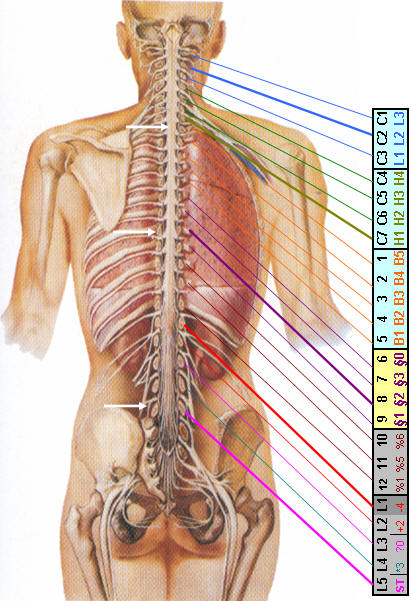| |
|
2.6) The Personally Relevant Psychosomatic Interface
(PRPI)
 |
There is a
functional analogy between the
physical vertebrae (Cervical 1-7, THoracic
1-12, Lubar vertebrae 1-5, and the "mental spine", our
ethical scale ranging from the
other-deter-minedness of the zeitgeist (ZG) up to L3=reframing.
This is relevant in dealing with
back pain,
say with
Dorn-Therapy, and
trauma treatment based on
Dr. Roger Callahan It can in fact be used to enhance the
generally available methods when accounting for the
individuality. In the back there is a kind of mapping
of psychologically unresolved problems, in terms of the
corresponding tension. That can result in spines being shifted,
which in turn irritates the adjacent nerves, which then causes
somatic problems in the
corresponding organs. Thus what is outlined here, can be
called the psycho-somatic interface.
It relates the inner modes of being with the corresponding
organs in a personally relevant way;
e.g. my value (v) is on H1, my
thinking (t) on H2, in conflict with the zeitgeist and
its asso-ciated political correctness: |
Specifically, here I am presenting a
more hopeful (H1) approach to personal healing, but which is in conflict
with the prevailing order (H2) in the world of
personally-neutral psychology, and
content-free medicine. And indeed, the weak point in my
vertebrae is, physically at C6,7, which corresponds mentally
to H1,2. Thus I need to exercise accordingly and make progress with my
project - here, with you. These ideas sum up years of practice,
also in a mother-child clinic together with a medical doctor. In fact we
developed a diagnostic technique which allows the patient to
physically relate to his symptom and sickness via the
spine
misalignment of the corresponding vertebrae. Relating to the
associated tension and pain, and to realigning the vertebrae, then that
allows for enhancement of the co-operation of the patient in
his therapy.
<=
=> |